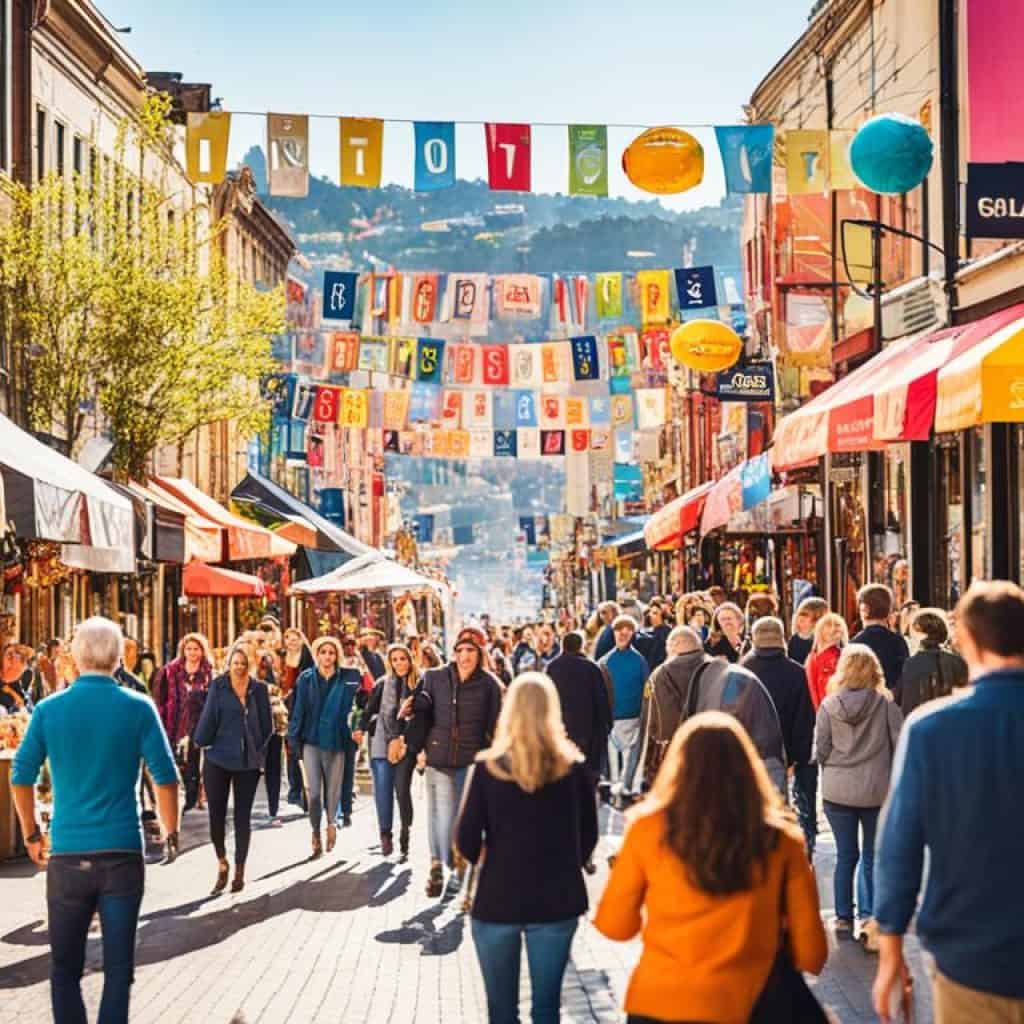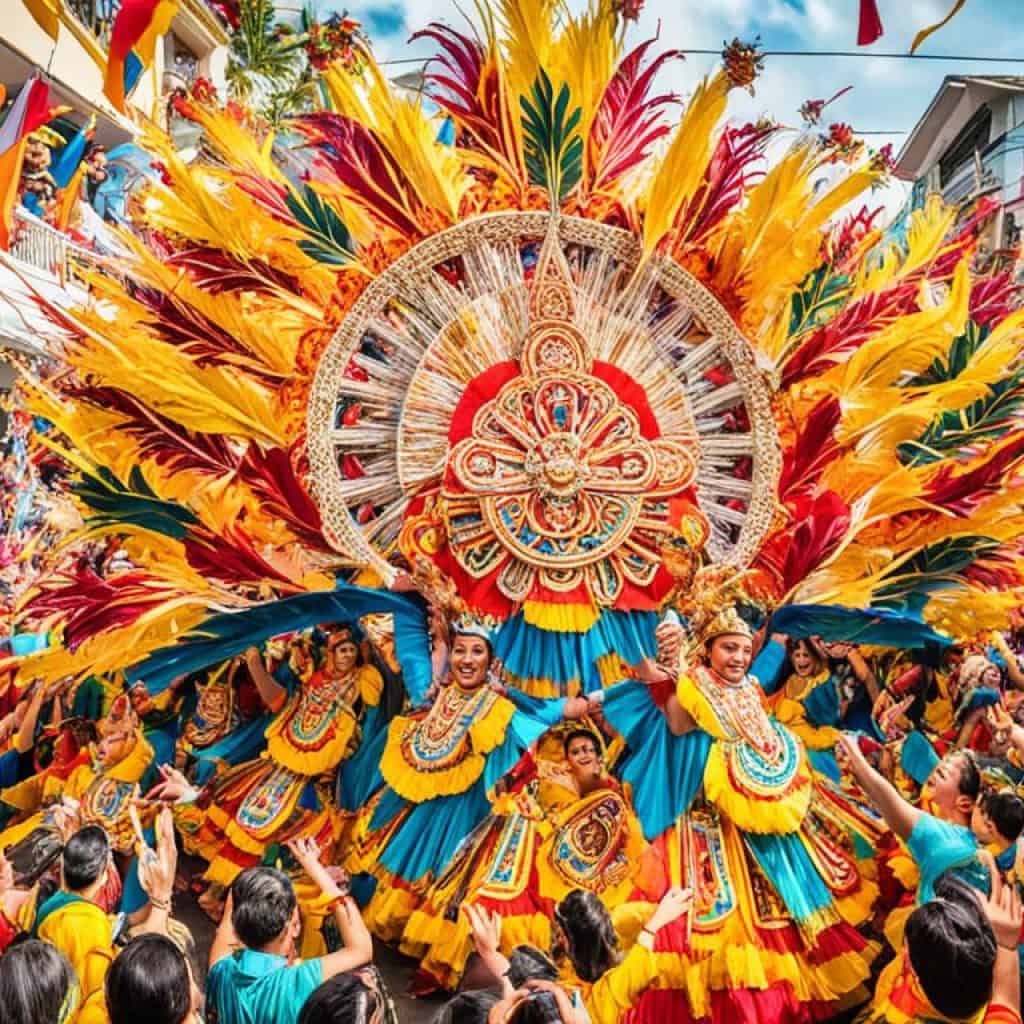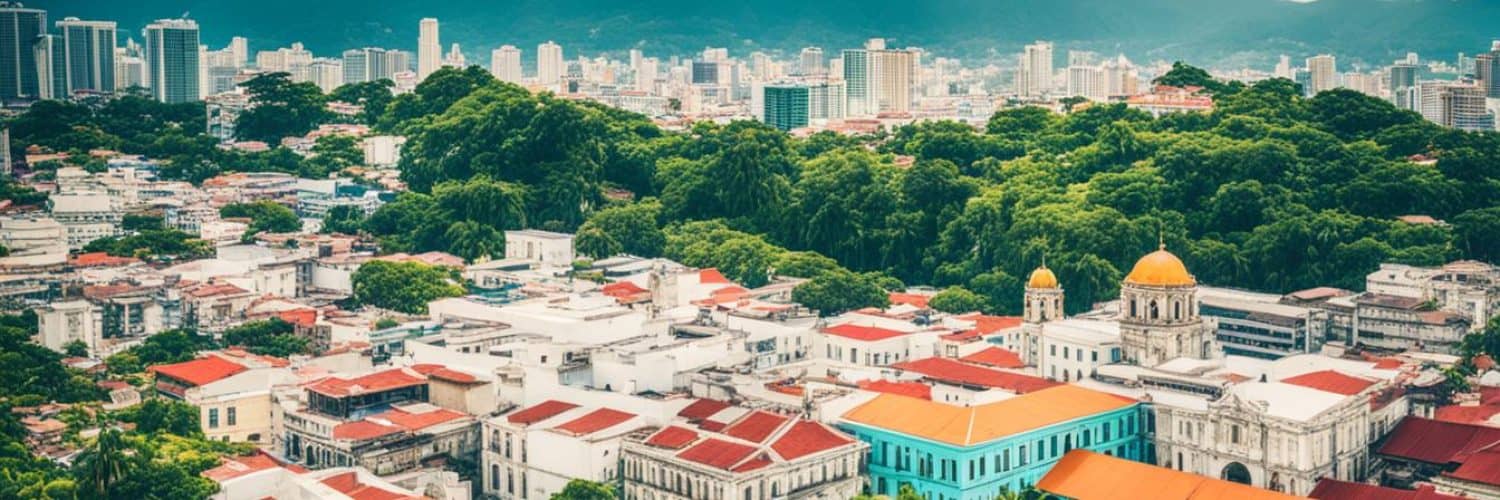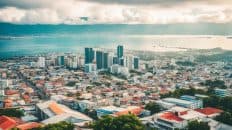Did you know that the oldest city in the Philippines is not Manila or any other well-known city? It is actually Cebu City, a hidden gem located in the Visayan region. With its rich historical significance and cultural heritage, Cebu City is a fascinating destination that takes you back in time to experience the roots of the Philippines.
Key Takeaways:
- Cebu City is the oldest city in the Philippines, steeped in historical significance and cultural heritage.
- The city is home to numerous heritage sites, including ancestral houses and Spanish-era landmarks.
- Heritage preservation is highly valued in Cebu City, ensuring the protection and maintenance of historical landmarks.
- Exploring Cebu City allows you to delve into the roots of the Philippines and experience its vibrant history and culture.
- Stay tuned to discover more about the captivating attractions and experiences that await you in Cebu City!
A City with Spanish Colonial Roots
Cebu City, located in the Visayan region of the Philippines, has a strong connection to the Spanish colonial era. This historic city was under Spanish rule for three centuries, leaving behind a legacy of historical landmarks that offer a glimpse into its rich past.
One of the most notable heritage sites in Cebu City is Fort San Pedro, a well-preserved Spanish fortress that served as a military defense structure during the colonial period. Constructed in the early 16th century, the fort now stands as a significant historical site and offers a fascinating look into the city’s past.
The Basilica del Santo Niño is another iconic landmark in Cebu City, dating back to the Spanish era. This centuries-old church houses the revered image of the Santo Niño, a symbol of Christianity and devotion in the Philippines. The basilica’s intricate architecture and religious significance attract both locals and tourists alike.
One of the highlights of Cebu City’s architectural heritage is Magellan’s Cross. Erected in 1521 by the Portuguese explorer Ferdinand Magellan, this cross symbolizes the introduction of Christianity to the Philippines. It stands as a testament to the city’s deep-rooted history and the enduring influence of the Spanish colonial era.
Colon Street, often referred to as the oldest street in the Philippines, is another significant landmark that reflects Cebu City’s Spanish colonial roots. Built by the Spaniards during their reign, this bustling street holds traces of the city’s past, with colonial-era buildings and vibrant shops lining its pathway.
Cebu City – A Haven of Spanish-Inspired Architecture
“The architectural heritage of Cebu City is a captivating tapestry of Spanish colonial influences that have stood the test of time. From the formidable walls of Fort San Pedro to the ornate details of the Basilica del Santo Niño, visitors are treated to a visual feast of rich history and cultural significance.”
– Cebu Heritage Society
Cebu City’s Spanish colonial architecture is a testament to the profound influence of the past. The city’s well-preserved historical landmarks and the charm of its oldest street offer a unique opportunity to step back in time and witness the enduring legacy of the Spanish colonial era.
| Historical Landmark | Description |
|---|---|
| Fort San Pedro | A Spanish fortress that served as a military defense structure during the colonial period. |
| Basilica del Santo Niño | A centuries-old church housing the revered image of the Santo Niño. |
| Magellan’s Cross | A prominent cross symbolizing the introduction of Christianity to the Philippines. |
| Colon Street | The oldest street in the Philippines, built by the Spaniards during their reign. |
A Treasure Trove of Ancestral Houses
When exploring the cultural heritage of Cebu City, one cannot miss the remarkable collection of ancestral houses. These architectural gems not only hold historical significance but also serve as tangible links to the city’s past.
These ancestral houses are a testament to the rich history and cultural heritage of Cebu City. They showcase the architectural style of bygone eras and provide a glimpse into the lives of the city’s prominent families.
Many of these houses have been meticulously preserved and restored, thanks to the dedicated efforts of heritage preservation groups. Today, these ancestral houses have been transformed into museums and cultural centers, offering visitors a unique opportunity to immerse themselves in the city’s vibrant history.
Inside these ancestral houses, visitors can admire the intricate details of the architecture, including beautiful wooden panels, grand staircases, and traditional furniture. Each house tells a story, allowing visitors to step back in time and experience the charm of a bygone era.
“The ancestral houses of Cebu City are living testaments to our cultural heritage and historical significance. They provide a tangible connection to our past and offer insights into the rich traditions and customs of our ancestors.” – Heritage Preservation Society of Cebu
These ancestral houses are not only valuable cultural artifacts but also important educational resources. Museums and cultural centers within these houses host exhibitions and educational programs, shedding light on the city’s history, traditions, and cultural practices.
Visiting these ancestral houses is a captivating experience that allows visitors to fully appreciate the historical significance and cultural heritage of Cebu City. It is an opportunity to gain a deeper understanding of the city’s identity and the contributions of its past inhabitants.
Experience Cebu City’s Ancestral Houses
If you’re planning a trip to Cebu City, include a visit to these notable ancestral houses in your itinerary:
- Yap-Sandiego Ancestral House – Built in the late 17th century, this ancestral house in Parian district showcases Spanish-Filipino architecture and boasts an impressive collection of antiquities.
- Colonial Pension House – Originally built as a residential house, this heritage building now serves as a bed and breakfast, offering guests a chance to stay in a piece of living history.
- Jesuit House – Known as the oldest house in the city, the Jesuit House dates back to the 17th century and showcases a blend of Spanish and Chinese architectural influences.
These ancestral houses in Cebu City are invaluable treasures that preserve the city’s cultural heritage and historical significance. They offer a glimpse into the past and provide a meaningful connection to the roots of this vibrant city.
The Birthplace of Christianity in the Far East
Cebu City, located in the Visayan region of the Philippines, holds a special place in the history of Christianity in the Far East. As the birthplace of Christianity in the region, it played a pivotal role in the spread of the faith. It was here in Cebu City where the first Christian baptism took place, marking a significant milestone in the religious landscape of the Far East.
Today, Cebu City is home to several historical landmarks associated with Christianity, providing a glimpse into its rich religious heritage. One of the most notable landmarks is the Basilica del Santo Niño, which houses the oldest religious relic in the country – the Santo Niño de Cebu. This relic holds immense cultural and spiritual significance, attracting thousands of devotees and tourists alike.
The Spanish colonial era left a lasting impact on Cebu City, and its influence can be seen in the grandeur of the religious structures that still stand today. The iconic Magellan’s Cross, planted by the Spanish explorer Ferdinand Magellan in 1521, serves as a symbol of the city’s Christian roots. It stands as a testament to the historical connection between Cebu City and the early spread of Christianity in the Philippines.
Historical Landmarks Associated with Christianity in Cebu City:
| Landmark | Description |
|---|---|
| Basilica del Santo Niño | A magnificent church that houses the Santo Niño de Cebu, the oldest religious relic in the country. |
| Magellan’s Cross | A historical landmark planted by Ferdinand Magellan, marking the introduction of Christianity in the Philippines. |
| Cebu Metropolitan Cathedral | A majestic cathedral that serves as the ecclesiastical seat of the Archdiocese of Cebu. |
Exploring these historical landmarks offers visitors a chance to delve into the rich cultural and religious heritage of Cebu City. The fusion of Spanish colonial influences and indigenous traditions provides a fascinating insight into the early days of Christianity in the Far East. It’s a journey that combines historical exploration with spiritual discovery, making it a must-visit destination for those interested in Christian history and cultural heritage.
A Hub of Heritage Tourism
For tourists interested in immersing themselves in the rich cultural heritage and exploring historical landmarks, Cebu City has become a popular destination for heritage tourism. Located in the heart of the Philippines, this city offers visitors a unique opportunity to delve into the vibrant past of the oldest city in the country.
One of the main attractions for heritage tourism in Cebu City is the abundance of well-preserved ancestral houses. These architectural treasures serve as a testament to the city’s historical significance and showcase the cultural heritage of the region. Visitors can stroll through neighborhoods like Parian and explore beautifully restored houses that offer a glimpse into the city’s past.
Another highlight of heritage tourism in Cebu City is the opportunity to visit significant historical sites. From the iconic Magellan’s Cross, which commemorates the arrival of Christianity in the Philippines, to Fort San Pedro, a military defense structure dating back to the Spanish colonial era, these landmarks provide a deeper understanding of the city’s history.
“Cebu City offers a captivating blend of cultural heritage and historical landmarks, making it an ideal destination for those seeking a truly immersive heritage tourism experience.”
The Oldest City of the Philippines
Cebu City’s status as the oldest city in the Philippines adds to its allure as a heritage tourism hub. Travelers have the opportunity to explore a city with a rich historical background and witness the legacy of the past. From the oldest street in the country, Colon Street, to the grandeur of the Basilica del Santo Niño, Cebu City proudly showcases its heritage.
Heritage tourism in Cebu City offers visitors a chance to connect with the roots of the Philippines and experience the cultural richness of the region. Whether it’s admiring ancestral houses, visiting historical landmarks, or simply immersing oneself in the vibrant atmosphere, Cebu City promises an unforgettable journey into the past.
Vibrant City Life and Modern Amenities
While exploring Cebu City’s historical significance and cultural heritage, don’t miss out on experiencing its vibrant city life and modern amenities. As an urban center, this bustling city offers a wide array of attractions and conveniences that cater to the needs and interests of both locals and tourists alike.
Cebu City is known for its dynamic and cosmopolitan atmosphere, making it a hub of activity and excitement. The city boasts numerous shopping malls where visitors can indulge in retail therapy, finding everything from high-end fashion brands to local crafts and souvenirs. In addition, Cebu City is a food lover’s paradise, with a diverse culinary scene that features both local and international cuisine. From enticing street food to upscale dining establishments, there’s something to satisfy every palate.

The Urban Center of Commerce
“Cebu City serves as the commercial center of the Visayan region, driving economic growth and providing opportunities for various industries. From mining and fishing to agriculture and shipbuilding, the city plays a vital role in the region’s economy.”
Aside from the vibrant city life, Cebu City offers modern amenities that cater to its residents and visitors. The city is equipped with excellent healthcare facilities, ensuring the well-being of its residents. It also has a well-developed transportation system that efficiently connects different parts of the city and its surrounding areas.
Entertainment and Recreation
If you’re looking for entertainment and recreation, Cebu City has plenty to offer. The city is home to numerous entertainment venues, including theaters, concert halls, and live music venues, where you can enjoy a variety of performances. For those who enjoy nightlife, Cebu City has a vibrant club scene with a wide selection of bars and nightclubs.
For outdoor enthusiasts, Cebu City has parks and recreational areas where you can relax, exercise, or simply enjoy the beautiful surroundings. The city is also known for its sports facilities, hosting various local and international events throughout the year.
A Gateway to Adventure
Beyond the city limits, Cebu City serves as a gateway to thrilling adventures and natural wonders. The city is strategically located, making it easy to explore the surrounding islands and attractions. From diving in crystal-clear waters to trekking through lush mountains, there are endless opportunities for adventure and exploration just a short distance away.
| Modern Amenities | Vibrant City Life | Urban Center | Commercial Center |
|---|---|---|---|
| Shopping malls | Cultural events and festivals | Transportation system | Economic growth |
| Excellent healthcare facilities | Nightlife and entertainment | Parks and recreation | Vibrant club scene |
| Local and international cuisine | Sports facilities | Outdoor adventure opportunities | Proximity to natural wonders |
With its modern amenities, vibrant city life, and status as a commercial center, Cebu City offers a perfect blend of historical charm and contemporary conveniences. Explore the city’s cultural heritage, immerse yourself in its lively atmosphere, and enjoy the modern comforts that make Cebu City a truly captivating destination.
Pristine Beaches and Island Getaways
While Cebu City is known for its historical landmarks, it also offers a tropical paradise for beach lovers. The city is surrounded by pristine beaches and picturesque islands that are perfect for a relaxing getaway.
For those seeking sun, sand, and sea, Cebu City has it all. Visitors can bask in the beauty of white sand beaches, crystal-clear waters, and stunning coral reefs. The nearby islands, such as Mactan Island and Bantayan Island, offer a serene escape from the bustling city life.
Beach tourism is a popular attraction in Cebu City, drawing visitors from all over the world. Whether you’re into sunbathing, swimming, snorkeling, or diving, the pristine beaches of Cebu City have something for everyone.
Island Hopping Adventure
If you’re looking to explore multiple islands in one trip, island hopping tours are a must-do activity. These tours allow visitors to hop from one island to another, discovering hidden gems along the way.
During an island hopping adventure, you can visit islands like Malapascua Island, known for its beautiful diving spots and thresher shark sightings, or Camotes Island, famous for its stunning beaches and turquoise waters. Each island has its own unique charm and attractions, making island hopping a memorable experience.
“Cebu City’s pristine beaches and island getaways offer a tropical paradise for beach lovers. Whether you’re looking for relaxation or adventure, the city’s surrounding islands have something for everyone.”
With its convenient location and easy access to popular destinations like Boracay, Cebu City serves as a gateway to more beach and island adventures in the Philippines. Many visitors use Cebu City as a base to explore the nearby islands and experience the beauty of the country’s beach tourism.
Culinary Delights of Cebu
Cebu City is a feast for the senses, not only for its historical landmarks and natural wonders but also for its culinary delights. The city’s vibrant food culture and rich gastronomic heritage make it a haven for food enthusiasts and tourists alike. Indulge in the authentic flavors of Cebu cuisine and discover a world of traditional dishes that will tantalize your taste buds.
One iconic dish that you must try when in Cebu is the famous Cebu Lechon. This succulent roasted suckling pig is known for its crispy skin and tender meat. It is often hailed as one of the best pork dishes in the country and is a must-have during celebrations and special occasions.
For the adventurous foodies, balut is a delicacy that should not be missed. This Filipino street food is a boiled duck embryo and is highly popular among locals. It may sound unusual, but many locals and tourists alike find its unique flavors and textures truly satisfying.
Cebu’s coastal location also makes it a paradise for seafood lovers. From grilled squid and shrimps to kinilaw (ceviche) and tinolang isda (fish soup), there’s an abundance of fresh and flavorful seafood dishes to savor. Don’t forget to try the mouthwatering ginataang alimango (crab cooked in coconut milk) for a truly indulgent experience.
When exploring Cebu City, make sure to immerse yourself in the local food scene. The city offers a wide array of dining options, from street food stalls to upscale restaurants, where you can savor the flavors of Cebu. Sample the local delicacies, such as puso (rice cooked in woven coconut leaves), which complements grilled dishes perfectly.
Must-Try Dishes in Cebu City
- Cebu Lechon – The iconic roasted suckling pig with crispy skin and tender meat.
- Balut – A boiled duck embryo, a unique delicacy for adventurous foodies.
- Tinolang Isda – A comforting fish soup cooked with vegetables and ginger.
- Ginataang Alimango – Crab cooked in creamy coconut milk, a rich and indulgent dish.
- Kinilaw – Cebu’s version of ceviche, featuring fresh raw fish marinated in vinegar and spices.
Experience the culinary delights of Cebu City and embark on a gastronomic adventure like no other. The city’s traditional dishes and food tourism scene will leave you craving for more. So, pack your appetite and get ready to savor the flavors of Cebu!
| Dish | Description | Restaurant Recommendation |
|---|---|---|
| Cebu Lechon | A roasted suckling pig with crispy skin and tender meat. | Zubuchon |
| Balut | A boiled duck embryo, a unique and adventurous delicacy. | Tin Gow Restaurant |
| Tinolang Isda | A comforting fish soup cooked with vegetables and ginger. | STK ta Bay! |
| Ginataang Alimango | Crab cooked in creamy coconut milk, a rich and indulgent dish. | Isla Sugbu Seafood City |
| Kinilaw | Cebu’s version of ceviche, featuring fresh raw fish marinated in vinegar and spices. | Manang Juling’s Kilawin |
Notable Landmarks and Attractions
Cebu City is a treasure trove of tourist attractions and notable landmarks. Whether you’re a history buff, a nature lover, or a spiritual seeker, there’s something for everyone to explore in this vibrant city.
Historical Sites
Step back in time and discover the historical sites that have shaped Cebu City’s rich heritage. Explore the massive stone walls of Fort San Pedro, the oldest and smallest fort in the Philippines. Marvel at the iconic Magellan’s Cross, a symbol of Cebu’s role in the country’s conversion to Christianity. These landmarks offer a glimpse into the city’s colonial past and are must-visit attractions for history enthusiasts.
Modern Landmarks
Cebu City is not only steeped in history but also boasts modern landmarks that showcase its rapid development. Visit the Cebu Taoist Temple, a serene place of worship that presents stunning architecture and sweeping city views. Admire the grandeur of the Cebu Metropolitan Cathedral, an imposing structure that serves as the spiritual center of the city. These modern landmarks offer a fascinating contrast to the historical sites and reflect the city’s progress.
Must-Visit Places
Cebu City is brimming with must-visit places that capture its unique charm and beauty. Pay homage to Lapu-Lapu, the island’s indigenous hero, at the Lapu-Lapu Shrine. Immerse yourself in the breathtaking experience of whale shark watching in Oslob. These unforgettable destinations allow you to explore the city’s natural wonders and cultural heritage in a truly immersive way.
“Cebu City is a captivating blend of history, culture, and natural beauty. Its notable landmarks and attractions offer a glimpse into the city’s past and present, enticing visitors from all over the world.”
Plan your itinerary and make sure to include these tourist attractions and must-visit places in your Cebu City adventure. From historical sites to modern landmarks, this city has it all. Discover the allure of Cebu City’s treasures and create lasting memories in one of the Philippines’ most captivating destinations.
Festivals and Cultural Celebrations
Cebu City is renowned for its lively festivals and vibrant cultural celebrations. One of the most famous events is the Sinulog Festival, an annual celebration that pays homage to the city’s patron saint, Santo Niño. This vibrant festival features colorful street parades, traditional dances, and religious processions, attracting locals and visitors alike. The Sinulog Festival is a captivating showcase of Cebu City’s rich cultural heritage and deep-rooted traditions.
Throughout the year, Cebu City hosts a plethora of fiestas and cultural events, creating a festive atmosphere that allows visitors to immerse themselves in the local culture. These celebrations provide a unique insight into the customs and traditions of the Cebuano people. From music and dance performances to street food vendors and arts and crafts exhibitions, the fiestas in Cebu City offer a sensory extravaganza for all.

One of the highlights of Cebu City’s cultural calendar is the Kadaugan sa Mactan festival. It commemorates the historic Battle of Mactan, where the native chieftain Lapu-Lapu triumphed over Spanish explorer Ferdinand Magellan. The festival showcases reenactments of the battle, parades, and cultural displays, bringing the fascinating history of Cebu City to life.
The rich cultural heritage of Cebu City is also celebrated during the Pasko Sa Sugbo, a month-long Christmas celebration. The city streets are adorned with festive decorations, and various activities and performances are held to create a joyful and merry atmosphere. Visitors can experience the Filipino traditions of Simbang Gabi (midnight mass) and partake in the vibrant street food scene during this festive season.
Incredible Festivals and Cultural Events in Cebu City:
- The Sinulog Festival: Celebrating the city’s patron saint, this festival is a dazzling display of music, dance, and religious processions.
- Kadaugan sa Mactan: Commemorating the historic Battle of Mactan, this festival features reenactments, parades, and cultural displays.
- Pasko Sa Sugbo: A month-long Christmas celebration filled with festive decorations, activities, and performances.
- Flores de Mayo: A religious festival dedicated to the Blessed Virgin Mary, featuring processions and floral offerings.
- Tinabuay Festival: Showcasing the cultural heritage of Daanbantayan town through street dances, colorful costumes, and traditional music.
These festivals and cultural celebrations in Cebu City are not only an opportunity for locals to express their pride and traditions but also a chance for visitors to immerse themselves in the vibrant culture and experience the warm hospitality of the Cebuano people.
| Festival/Cultural Event | Description |
|---|---|
| Sinulog Festival | A grand celebration honoring Santo Niño with street parades, traditional dances, and religious processions. |
| Kadaugan sa Mactan | Commemorates the Battle of Mactan with reenactments, parades, and cultural displays. |
| Pasko Sa Sugbo | A month-long Christmas celebration featuring festive decorations, activities, and performances. |
| Flores de Mayo | A religious festival dedicated to the Blessed Virgin Mary, with processions and floral offerings. |
| Tinabuay Festival | Highlights the cultural heritage of Daanbantayan town through street dances, colorful costumes, and traditional music. |
Queen City of the South
Cebu City, known as the “Queen City of the South,” holds a special place in the hearts of Filipinos and visitors alike. Its nickname reflects the city’s historical significance and vibrant urban life, making it a captivating destination worth exploring. As the capital of Southern Philippines, Cebu City embodies the spirit of the region and offers a unique blend of old-world charm and modernity.
With its rich historical heritage and cultural landmarks, Cebu City stands as a testament to the country’s past. Its historical significance can be witnessed through the Spanish colonial-era architecture that adorns the city, including the iconic Basilica del Santo Niño and Magellan’s Cross. These landmarks serve as a gateway to the city’s intriguing past, allowing visitors to immerse themselves in its rich history.
“Cebu City, the Queen City of the South, embraces its cultural heritage with open arms. Its historical landmarks and vibrant urban life create a unique charm that attracts tourists from all over the world.”
However, Cebu City is not just about its historical significance. It thrives as a modern urban center, offering a vibrant city life with an array of shopping malls, restaurants, and entertainment options. The city’s commercial hub status attracts various industries, contributing to its bustling and dynamic atmosphere.
As if the historical and contemporary aspects weren’t enough, Cebu City also boasts pristine beaches and breathtaking island getaways. The city’s strategic location provides easy access to nearby tropical paradises, where visitors can revel in the beauty of white sand beaches and indulge in exhilarating water activities.
When it comes to food, Cebu City is a culinary hotspot that never fails to tantalize taste buds. The city’s cuisine, known for its unique flavors and mouthwatering dishes, is a gastronomic delight. Be sure to try the famous Cebu Lechon, a succulent roasted pig that is a true testament to the city’s culinary prowess.
Whether you’re exploring historical landmarks, indulging in local cuisine, or enjoying the vibrant city life, Cebu City offers an unforgettable experience. Its nickname, the “Queen City of the South,” is well-deserved, representing the city’s historical significance, cultural heritage, and vibrant urban lifestyle. Discover the charm of Cebu City and immerse yourself in its captivating allure.
Best Time to Visit Cebu City
If you’re planning a trip to Cebu City, it’s important to consider the best time to visit in order to make the most of your experience. The ideal time to explore this vibrant city is during the dry season, which runs from December to May.
During these months, Cebu City offers visitors favorable weather conditions, making it perfect for outdoor activities such as beach visits and sightseeing. You can enjoy the sunny days and pleasant temperatures as you explore the city’s attractions and historical landmarks.
On the other hand, it’s important to note that the wet season in Cebu City occurs from May to October. This period sees an increase in rainfall and humidity, which may not be ideal for sightseeing or outdoor activities. Heavy downpours can disrupt your plans and make it challenging to fully enjoy the city’s offerings.
By planning your trip during the dry season, you can avoid the inconveniences caused by rain and ensure a more enjoyable experience. The pleasant weather allows you to take full advantage of the city’s beautiful beaches, explore the historical sites, and immerse yourself in the vibrant culture of Cebu City.
So, if you’re looking to make the most of your visit to Cebu City, plan your trip between December and May for the best weather and optimal conditions to explore and enjoy all that this amazing city has to offer.
Summary of Best Time to Visit Cebu City
| Season | Weather | Activities |
|---|---|---|
| Dry Season (December to May) | Sunny days, pleasant temperatures | Beach visits, sightseeing, outdoor activities |
| Wet Season (May to October) | Increased rainfall, higher humidity | Potential disruptions, less ideal for outdoor activities |
Captivating Experiences in Cebu City
When it comes to Cebu City, there are no shortage of unique experiences and exciting things to do. Whether you’re an adventure seeker or a culture enthusiast, this vibrant city has something to offer for everyone.
One of the most captivating experiences in Cebu City is diving with whale sharks in Oslob. This thrilling activity allows you to get up close and personal with these majestic creatures and create memories that will last a lifetime. If you prefer to stay on land, you can explore the stunning Kawasan Falls, where you can swim in crystal-clear turquoise waters and admire the beauty of nature.
To truly immerse yourself in the local culture, a visit to the traditional markets is a must. These bustling marketplaces offer a unique shopping experience where you can find local handicrafts, fresh produce, and sample delicious street food. You can also try your hand at traditional crafts by participating in workshops and learning from skilled artisans.
Cebu City is also known for its vibrant festivals and cultural events. The Sinulog Festival, held every January, is a spectacular display of colorful street parades, traditional dances, and religious processions. It’s an opportunity to witness the rich heritage and traditions of the city.
Cebu City provides a myriad of captivating experiences that will leave you with unforgettable memories. From diving with whale sharks to exploring magnificent waterfalls, from immersing yourself in the local culture to celebrating vibrant festivals – there’s no shortage of things to do and see in this remarkable city.
Attractions in Cebu City
If you’re looking for more attractions to add to your Cebu City itinerary, here are a few popular options:
- The Basilica del Santo Niño: A historically significant religious site that houses the oldest religious relic in the Philippines.
- Fort San Pedro: A Spanish-era fortress that offers a glimpse into Cebu City’s colonial past.
- The Cebu Metropolitan Cathedral: A stunning church that showcases beautiful architecture and religious artifacts.
- Lapu-Lapu Shrine: A monument dedicated to the first Filipino hero, Lapu-Lapu, who resisted Spanish colonization.
- Oslob Whale Shark Watching: An opportunity to witness and swim alongside gentle whale sharks in their natural habitat.
These attractions, along with the captivating experiences mentioned earlier, make Cebu City a must-visit destination for travelers seeking a blend of adventure, culture, and natural beauty.
Top Attractions in Cebu City
| Attraction | Description |
|---|---|
| Basilica del Santo Niño | A historically significant religious site that houses the oldest religious relic in the Philippines. |
| Fort San Pedro | A Spanish-era fortress that offers a glimpse into Cebu City’s colonial past. |
| Cebu Metropolitan Cathedral | A stunning church that showcases beautiful architecture and religious artifacts. |
| Lapu-Lapu Shrine | A monument dedicated to the first Filipino hero, Lapu-Lapu, who resisted Spanish colonization. |
| Oslob Whale Shark Watching | An opportunity to witness and swim alongside gentle whale sharks in their natural habitat. |
Conclusion
Cebu City, as the oldest city in the Philippines, proudly showcases its rich cultural heritage and historical landmarks. With its vibrant tourism scene, it has become a must-visit destination for travelers seeking to delve into the roots of the country. From exploring the Spanish colonial era and indulging in local cuisine to lounging on pristine beaches, Cebu City offers a diverse array of experiences for every traveler.
Steeped in history, the city’s historical landmarks, such as Fort San Pedro and Magellan’s Cross, provide a glimpse into its past. Visitors can immerse themselves in the city’s cultural heritage by exploring well-preserved ancestral houses and its renowned Basilica del Santo Niño, an iconic symbol of Christianity in the Far East.
Moreover, Cebu City’s tourism scene extends beyond its cultural appeal. Its picturesque beaches and stunning island getaways, combined with modern amenities, beckon visitors from around the world. Whether you’re looking to relax on pristine white sand beaches or embark on thrilling water activities, Cebu City has it all.
In conclusion, Cebu City truly stands as a testament to the oldest city of the Philippines, capturing the hearts of tourists with its unique blend of cultural heritage, historical landmarks, and abundant tourism opportunities. Embark on a journey through time and experience the wonders this captivating city has to offer.


















Add comment